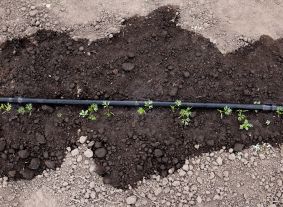How to Eliminate Cabbage Worms
Views: 4590
About two months ago I had this fantastic idea: Sow seeds of bitter-tasting veggies such as kale and arugula in the large planter near my home’s front porch. Since this spot is far from the garden, this would be a safe place for them, far away from the tiny flea beetles that mow down the seedlings of kale and arugula (and other bitter plants) as they emerge. My plan worked. No flea beetles. Success. Well, sort of. The kale seedlings were beetle-free. But—and there is always a but in gardening—a new critter came along to wreak havoc on them. Somehow, and from somewhere, a cabbage worm found its way into my tiny front porch planting.
Signs of Cabbage Worm Infestation
Here’s how I knew something was wrong: I had been checking my kale seedlings every day. One day I noticed a small hole in a leaf. The next day, another hole. The day after, the entire leaf except for the midrib was GONE. That’s when I noticed the damage on other kale leaves nearby. Upon closer inspection, the kind of inspection I should have been giving them the whole time, I noticed a small, silky green worm or caterpillar at the base of the now-gone leaf.
A little research revealed the culprit as a critter generally termed a cabbage worm. It’s the larval stage of one of three different species of butterfly that feed on brassicas—veggies such as cabbage, cauliflower, broccoli and kale.
As with the damage I saw, you’ll first see signs of cabbage worm damage as small holes in the center of leaves. Then you’ll notice whole leaves missing.
For anything that creates a head, such as cabbage or cauliflower, you also may notice small entry holes in the top of the head. The damage can range in severity. On small plants, cabbage worms can eat the entire plant, causing it to die. On larger plants, the damage can be minimal and just unsightly. Regardless of severity, you’ll want to eliminate any cabbage worms you find to discontinue the life cycle.
Butterflies vs. Cabbage Worms
The adult butterfly is deceivingly beautiful. It is whitish and floats lightly along the breeze, hopping from plant to plant.
The adult, however, is not the stage that causes the damage. It’s the inchworm-looking caterpillar that voraciously eats leaves, even boring its way deep into a head of cabbage.
The adult lays eggs on the underside of brassica leaves in spring, and these eggs hatch in less than a week. The caterpillars then eat themselves silly to give them energy to form a chrysalis for winter, which then becomes a butterfly the following spring, repeating the whole darn process.
How to Prevent Cabbage Worm Damage
Inspect your plants often, checking the tops and bottoms of the leaves. Remove and kill (squish) any cabbage worms you find.
The butterflies will find their way to your garden from elsewhere, however. The best thing to do to eliminate them from your garden is to prevent them from laying eggs on your crops from the beginning of spring. You can do this by placing a floating row cover over your seedlings (whether they are transplants or emerging seedlings) in the spring and early summer. This will prevent those oh-so-beautiful butterflies from laying eggs on your crops in the first place.
Meet Ellen Wells
When you’re raised on a farm, you can’t help but know a thing or two about gardening. Ellen Wells is our expert on edible gardening.…
Ellen's Recent Posts

Asparagus






